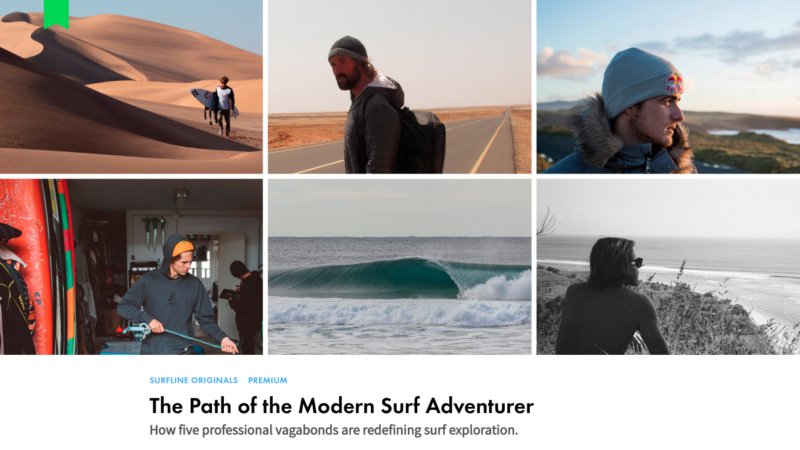LINK A LA NOTA: https://www.surfline.com/surf-news/path-modern-surf-adventurer/66785
The Path of the Modern Surf Adventurer
How five professional vagabonds are redefining surf exploration.
By Matt Rode
In the beginning, surfers were just surfers. It wasn’t until the World Tour was monetized and surf brands began signing athletes to big-dollar contracts that surfing became a legitimate career option. And before long, that career path diverged into two paths: that of the professional competitor and that of the professional freesurfer.
Unlike other sports that rely on the quantifiable nature of competitive results to assign value to athletes, surfing is as much a lifestyle and a popular art as it is a sport. And while tour rankings might be a relatively reliable barometer of a surfer’s worth, they have much less impact on fans’ lives than the imagery we see online and in print, or even the performances of the standout surfers at our local breaks.
Surf companies figured out early on that associating themselves with talented, interesting and aesthetically pleasing surfers sells product, and by the 1990s a career as a freesurfer became as viable as a competitor. An eclectic blend of characters came on the scene to eschew competition for a seemingly endless succession of sponsor-funded trips intended to generate magazine-worthy images and mindblowing video clips. In the early 2000s, the transition to a digital platform changed the entire surf industry, making online content not only a legitimate alternative to analog, but in many cases the preferred medium. Websites soon outnumbered print magazines, while the proliferation of free, online edits virtually killed surf filmmaking overnight. Meanwhile, the advent of social media provided an entirely new set of opportunities for surfers to prove their value to sponsors by feeding an endless stream of content to a global audience.
Pro surfing was no longer reserved for the anointed few endorsed by large brands and established magazines; but virtually anyone who could prove their worth as an “influencer.” Yet, for the most part, this new horde of freesurfing influencers failed to do anything original. Aside from a handful of unique environmental projects and artistic angles, pretty much everyone continued to use the same formula that had been in play for decades: fly to a pretty locale with guaranteed waves, generate a few shots and clips, publish, repeat.
Only in the past five years has a new type of freesurfer emerged: the self-motivated, self-informed surf adventurer. They’re redefining what it means to be a professional vagabond, striking out on their own to find and shred the last few remaining, undiscovered waves in the world. Leveraging flexible sponsor contracts, extensive global networks, and tools like Google Earth, they have carved out a niche that not only pays dividends in the way of perfect, empty surf, but has also reinvigorated the pioneering wanderlust that defined surf exploration in the 1970s.
To get a better idea of the job description, its challenges and its rewards, Surfline sat down with five men who epitomize this new freesurfing niche: Natxo Gonzalez, Kepa Acero, Nic Von Rupp, William Allioti and Jonathan Gubbins.
Surfline: To find success in this sport, one typically has to be extremely motivated, even as a freesurfer. Do you have any specific goals for your career?
Jonathan: My original goal was to get to know some of the best waves in the world, and to become known for my approach to them — not just getting barreled, but continually evolving and making every video edit way better than the last one. I spend a lot of time analyzing my stance, my style, and my boards with the images I get. Then I make a plan for the next swell. As time goes by, I feel more comfortable and more motivated.
You guys always seem to be on the road, chasing swells and sniffing out new spots. How do you make this happen, in terms of financial and practical logistics?
Jonathan: I’ve been working with Billabong for a long time and have other sponsors like Kia, Reebok and Coca Cola. My idea since the beginning was to get the best waves in the world on the best swells. I wanted to shoot them, create quality footage, and have a distinctive approach to the barrel. I worked with Rusty and Tokoro to design special boards — kind of small and heavy with a lot of volume, but super thin rails for standing close to the nose and maneuvering the barrel. I focused on Indo, Africa, Tahiti and Peru, and I have good friends who live in those places, so working with them on figuring out logistics is a big help.
Do you have a team that travels with you — any specific filmers, photographers or editors that you work with?
Jonathan: I have a team everywhere I go. In Africa I work with Bernt Bruns, Craig Moreland and Michael Veltman; in Tahiti I work with Huaprod; in Peru it’s Kirfa Lens; and in Indo it’s Justis St John and Pepe Romo. But lately, Justis has also been traveling with me to Peru and Africa, helping me out with swells, edits and filming. He’s such a legend.
Do you see other professional surf adventurers who are seeing success as your competition?
Jonathan: I always look at what other people are doing. It motivates me and gets me more stoked. But when I’m at the same spots and swells with other guys, I want to pull the best clips and make the best edits. I am definitely competitive, but mostly I focus on doing my own thing.


Leave A Comment?